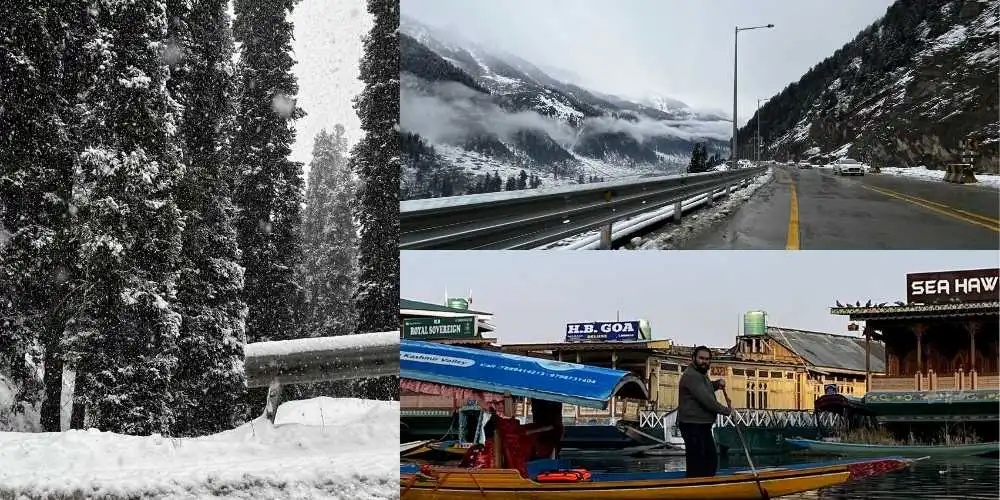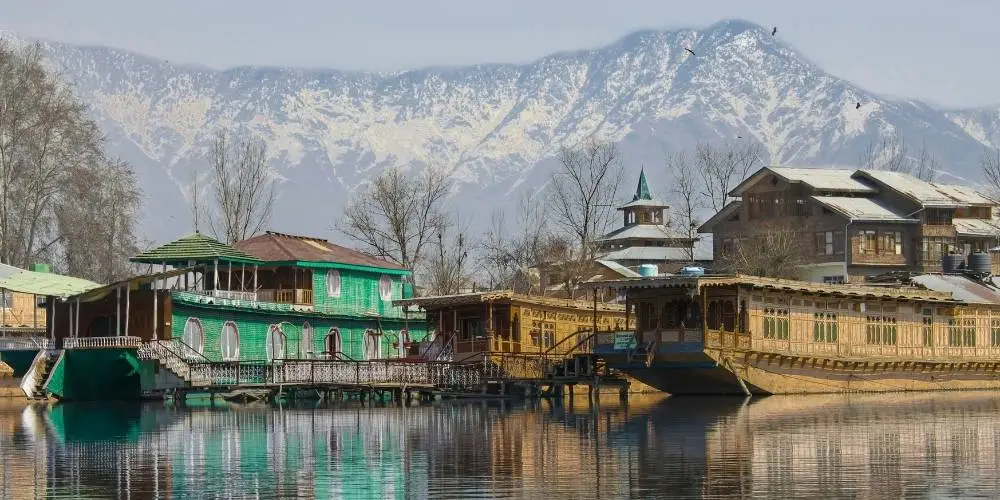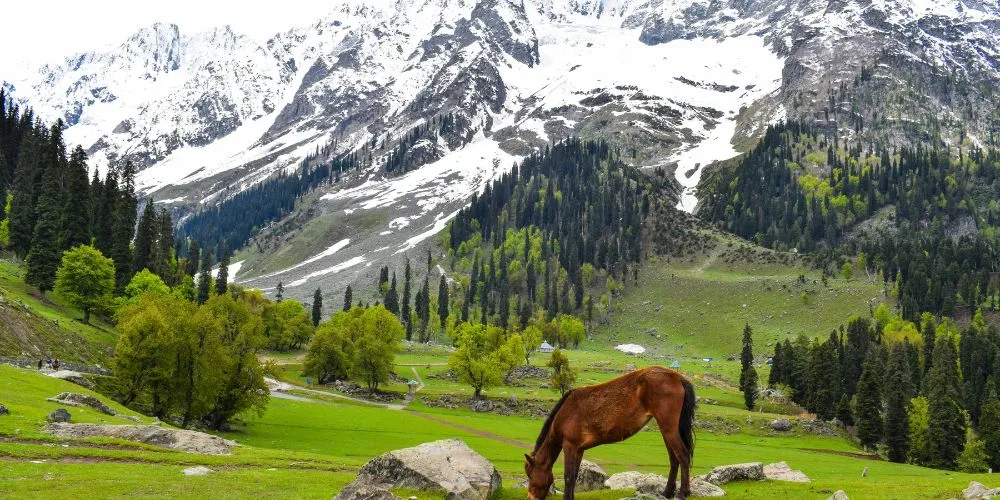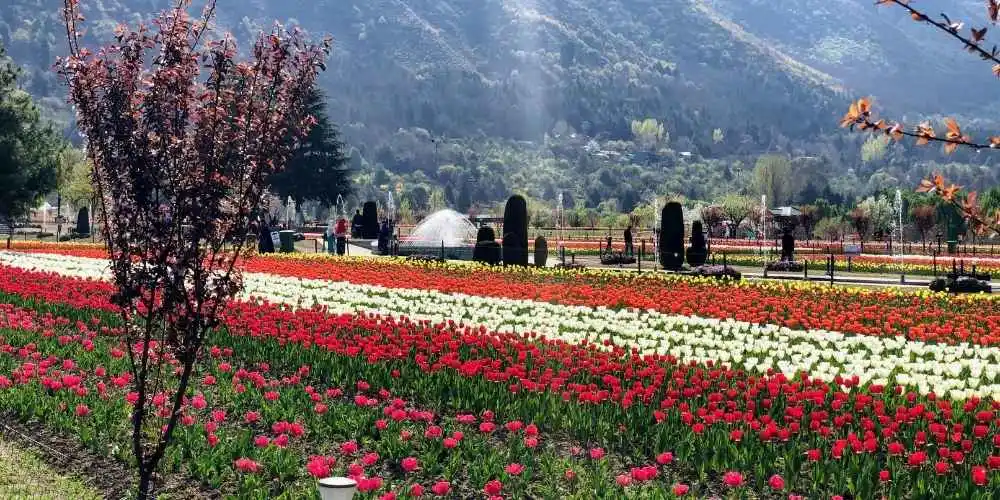If there’s a place on Earth that comes closest to paradise, it’s Kashmir. Surrounded by the mighty Himalayas, decorated with endless meadows, shimmering lakes, and apple orchards, Kashmir’s natural beauty is astonishing all year round. But the region’s allure isn’t just its stunning scenery; Kashmir is a rich tapestry of culture, cuisine, and warm hospitality, making every visit unforgettable.
Kashmir Weather and Best Time to Visit
Kashmir experiences all four seasons in their full glory, which is why the best time to visit Kashmir really depends on what you want to experience. If you dream of seeing tulips in bloom and gardens bursting with colour, March to early May is perfect. Summer (May to August) offers pleasant temperatures ranging from 15°C to 30°C, clear blue skies, and endless green landscapes; ideal for sightseeing, trekking, or lazy shikara rides on Dal Lake. This window is especially popular among families and honeymooners.
Those chasing snow should visit between December and February, when Kashmir transforms into a white wonderland; think snow-draped Gulmarg slopes, crystalline rivers, and frozen meadows. Autumn (mid-September to November) is another magical season, with Chinar trees turning the valley gold and russet. Monsoon (July and August) is the off-season; while crowds dwindle and rates drop, rains may occasionally restrict outdoor activities.

Top Attractions in Kashmir
Kashmir’s most popular spots are classics for a reason, but there are plenty of lesser-known spots too. Here’s what you shouldn’t miss:
Srinagar: Srinagar is Kashmir’s lively heart, famed for the iconic Dal Lake. Spend hours floating in a shikara or staying overnight in a heritage houseboat, surrounded by lotus gardens and snow-capped peaks. Visit Mughal Gardens like Nishat Bagh and Shalimar Bagh for a taste of Persian-inspired grandeur, then browse the old city’s bustling bazaars for pashmina shawls and handcrafied carpets.

Dal Lake Srinagar
Gulmarg: Just under two hours from Srinagar, Gulmarg is a year-round playground. Summer brings green meadows and wildflowers, while winter draws skiers from all over the world for its powdery slopes and Asia’s highest cable car ride; the Gulmarg Gondola. Beginners and experts flock here for world-class skiing, snowboarding, and snowshoeing.
Pahalgam: This riverside hamlet is beloved for Betaab Valley, Aru Valley, and lush hiking trails along the Lidder River. Pahalgam’s weather is gentle in summer, making it wonderful for treks, pony rides, and picnics, while the apple orchards and saffron fields are a photographer’s dream.
Sonamarg: Known as the ‘Meadow of Gold,’ Sonamarg is surrounded by lofiy peaks and glaciers. It’s the launching point for the famous Amarnath Yatra and a magnet for trekkers, campers, and trout fishing enthusiasts.

Sonmarg
Yusmarg, Doodhpathri & Gurez Valley: These less-explored destinations offer tranquillity, meadows, and spectacular landscapes, ideal for travellers seeking a quieter side of Kashmir.
Ideal Number of Days and Sample Itinerary
The ideal Kashmir trip spans 6–8 days. This gives you time to explore Srinagar, Gulmarg, Pahalgam, and Sonamarg without rushing. A suggested itinerary might be: two nights in Srinagar (houseboat stay and city sightseeing), two in Gulmarg (adventure sports and meadows), two in Pahalgam (nature walks and valleys), and a day trip to Sonamarg.
Travel, Stay, and Permits
Kashmir is well-connected by air, with Srinagar International Airport receiving flights from major Indian cities. Jammu serves as the closest railway station, while taxis and buses offer intercity travel. Local taxis, auto-rickshaws, and shared cabs are the most convenient ways to get around tourist areas.
For most of Kashmir, Indian tourists don’t need permits. However, places close to the Line of Control (like Gurez, Turtuk) do require special permits, which are easily arranged via local authorities or hotels. Always carry a government ID and a few passport-size photos for documentation at all times.
Options for accommodation include luxurious resorts, charming boutique hotels, traditional houseboats, and budget guesthouses. Srinagar’s houseboats offer an unmatched experience, while Gulmarg and Pahalgam have everything from five-star properties to homestays surrounded by nature.

Tulip Garden, Srinagar
Packing Tips for Kashmir
Here is what you should pack according to the season:
- Summer: Light woollens, T-shirts, a windcheater or jacket for cool evenings.
- Winter: Heavy woollens, thermals, waterproof jackets, gloves, scarves, and boots.
- Monsoon: Quick-dry wear, sturdy shoes, umbrella or raincoat, and waterproof jackets.
Leave room for shopping; embroidered kurtas, pashmina shawls, saffron, dry fruits, and papier-mâché crafis are signature Kashmiri souvenirs.
Local Cuisine & Experiences
No Kashmir trip is complete without sampling its cuisine. Try Rogan Josh, Yakhni, Dum Aloo, Haak Saag, and the iconic Wazwan feast. Sip saffron-infused Kahwa tea afier a snowy trek, munch on bakery treats at Srinagar’s old-school shops, and savour fresh trout in Pahalgam.
Don’t miss experiencing a shikara ride at sunrise, walking through Mughal gardens, or enjoying folk music and dance in local fairs. Adventure lovers can go trekking, river rafiing, skiing, or sledging depending on the season.
To Conclude
Kashmir lives up to its legendary title as the “Heaven on Earth.” From its jewel-toned lakes and flower-filled gardens to its snow-cloaked slopes and rich traditions, every turn feels like a painting brought to life. With a bit of planning, Kashmir can be the perfect holiday destination if the timing of your trip, the weather, wise packing, and stay arrangements, are in line with your ideal adventure.
By: Anushka Singhal
